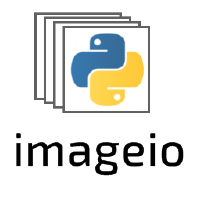Bird’s eye view on ImageIO#
The aim of this page is to give you a high level overview of how ImageIO works under the hood. We think this is useful for two reasons:
If something doesn’t work as it should, you need to know where to search for causes. The overview on this page aims to help you in this regard by giving you an idea of how things work, and - hence - where things may go sideways.
If you do find a bug and decide to report it, this page helps us establish some joint vocabulary so that we can quickly get onto the same page, figure out what’s broken, and how to fix it.
Terminology#
You can think of ImageIO in three parts that work in sequence in order to load an image.
- ImageIO Core
The user-facing APIs (legacy + v3) and a plugin manager. You send requests to iio.core and it uses a set of plugins (see below) to figure out which backend (see below) to use to fulfill your request. It does so by (intelligently) searching a matching plugin, or by sending the request to the plugin you specified explicitly.
- Plugin
A backend-facing adapter/wrapper that responds to a request from iio.core. It can convert a request that comes from iio.core into a sequence of instructions for the backend that fulfill the request (eg., read/write/iter). A plugin is also aware if its backend is or isn’t installed and handles this case appropriately, e.g., it deactivates itself if the backend isn’t present.
- Backend Library
A (potentially 3d party) library that can read and/or write images or image-like objects (videos, etc.). Every backend is optional, so it is up to you to decide which backends to install depending on your needs. Examples for backends are pillow, tifffile, or ffmpeg.
- ImageResource
A blob of data that contains image data. Typically, this is a file on your drive that is read by ImageIO. However, other sources such as HTTP or file objects are possible, too.
Issues#
In this repo, we maintain ImageIO Core as well as all the plugins. If you find a bug or have a problem with either the core or any of the plugins, please open a new issue here.
If you find a bug or have problems with a specific backend, e.g. reading is very slow, please file an issue upstream (the place where the backend is maintained). When in doubt, you can always ask us, and we will redirect you appropriately.
New Plugins#
If you end up writing a new plugin, we very much welcome you to contribute it back to us so that we can offer as expansive a list of backends and supported formats as possible. In return, we help you maintain the plugin - note: a plugin is typically different from the backend - and make sure that changes to ImageIO don’t break your plugin. This we can only guarantee if it is part of the codebase, because we can (a) write unit tests for it and (b) update your plugin to take advantage of new features. That said, we generally try to be backward-compatible whenever possible.
The backend itself lives elsewhere, usually in a different repository. Not vendoring backends and storing a copy here keeps things lightweight yet powerful. We can, first of all, directly access any new updates or features that a backend may introduce. Second, we avoid forcing users that won’t use a specific backend to go through its, potentially complicated, installation process.
